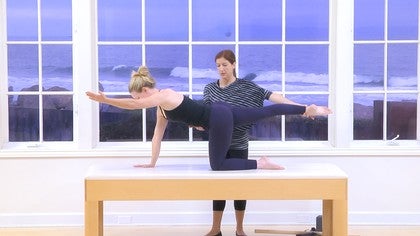Sacroiliac Dysfunction
Sherri Betz
Tutorial 2037
Watch this Tutorial

Sherri Betz
Likewise, standing in a single leg position on my right, if I lift my left knee as in marching and my left side hikes then would that be a function of my left glutes and I should cue the left glutes to anchor the pelvis? No, if you are standing on the right leg, it is a function of the RIGHT gluteus medius that holds the pelvis up. Try this: place your hands on your gluteus medius B with your legs apart and shift right and left. Then stand with your feet together and shift. You will immediately feel the contraction of the SAME side gluteus medius as you shift the the right, the right GMed will contract. Think of it as the weightbearing side in bridging or in standing that is actively working to support the pelvis. If you place your hands on the muscles, you can easily feel which side is contracting...
4 years ago
Martha R great question! My four fingers span across her lumbar spinous processes from L2-L5. I want mostly to feel what L3-4-5 are doing. I want to make sure that they are not shifting forward or upward when she is lifting her legs. This would mean that the abdominals are not working enough and the psoas is pulling the lumbar vertebrae forward into extension...this indicates poor abdominal wall and intra-abdominal pressure management of the lumbar spine.
4 years ago
Joan B I think that anything that helps you feel your body and activate more control is great! I often put people on a harder surface to help them feel their bones. Sometimes the Trapeze Table is too soft for the client to feel their bones on the mat. With chronic pain, there is often a downregulation of sensitivity of the nervous system. (like trying to block the pain-blocks ALL sensation to the painful area)
4 years ago
Rachel A it is best to get a physical therapist to evaluate your pelvic position. Then you can be assured that the dowel is placed properly. The leg on the same side of the anterior ilial rotation goes on top of the dowel. R anterior ilial torsion = R leg on top of the dowel.
1 year ago
Absolutely brilliant! I feel instant relief and cannot wait to repeat and share with several clients who will also benefit. Thank you so very much!
3 mos ago
Dear Sherri, 1st of all, Thank you so much for this video that I watch again in 2025 !! I have a question about 1st exercice with a stick. Could you please explain why did you choose to place the stick this way ? You mentioned that Amy's pelvis was shifted to the right and you want her to improve a posterior pelvis tilt on the R side and anterior on the left side. Does it mean that her pelvis was rotated to the LEFT ? What kind of test should we use to choose then the side we need to work with ? Thank you !! Assya
2 mos ago
Assya L I am so glad that you benefitted from the session! I did not mean to imply that her pelvis was rotated to the left or right. The stick correction was only for correcting the R anterior and L posterior ilium. I don't feel comfortable giving any other instructions other than what I taught on the video without seeing the patient. I would recommend sending the client to a physical therapist for a thorough assessment of the pelvic girdle if the broomstick technique doesn't work. Thank you so much for your positive feedback! Best to you in working with your clients! I can tell you are enthusiastic about this work.
2 mos ago
161-169 of 169
You need to be a subscriber to post a comment.
Please Log In or Create an Account to start your free trial.







































































